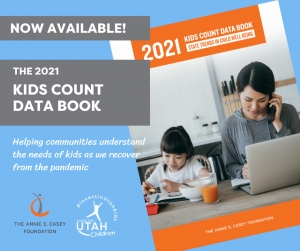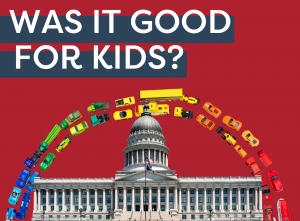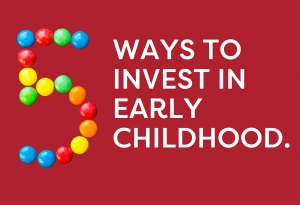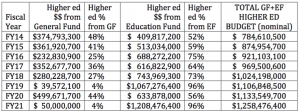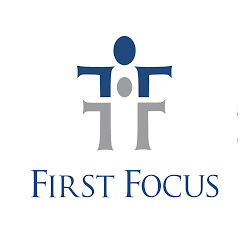Child Care
2021 Kids Count Data Book is Now Available!
We are pleased to announce that the Annie E. Casey Foundation has released the 2021 Kids Count Data Book.
Access the book today at www.aecf.org/databook
Background
For 15 years it has been the priority of the Utah KIDS COUNT Project to ensure that policymakers, advocates, community service providers, the media, and concerned citizens have quality data on how children are doing in our state. These yearly publications provide county level data on a variety of child well-being indicators.Utah showed strong gains in key indicators of child well-being from 2010 to 2019, according to the 2021 KIDS COUNT® Data Book, a 50-state report on child well-being by the Annie E. Casey Foundation analyzing how children are doing in four domains encompassing 16 child well-being indicators.
Summary of the 2021 Utah Kids Count Data
This year’s Data Book shows nearly a decade of progress in all but two of the indicators.
Troublesome indicators appear in the Health domain as low birth-weight babies and child and teen death rates both saw increases over the decade. The percentage of babies born at low birth weight rose from 7.0% in 2010 to 7.4% in 2019, a 6% increase; Utah fell in the national rankings from 12th to13th in this indicator. Similarly, the child and teen death rate rose from 24 deaths per 100,000 children in 2010 to 26 in 2019, an 8% increase. Utah fell in the rankings for this indicator from 14th to 24th.
While Utah showed improvement in most areas of child well-being over the last decade, when comparing 2020 data to 2021 data our rankings from last year fell in all but one category:
- Overall ranking fell from 4th to 5th
- Economic Well-Being fell from 2nd to 5th
- Health ranking fell from 13th to 18th
- Family and Community fell from 1st to 2nd
- Education remained the same at 10th
“The bad news is Utah is not keeping pace with the states that continue to improve,” said Terry Haven, deputy director of Voices for Utah Children, Utah’s member of the KIDS COUNT network.
“The good news is it wouldn’t take much to help our rankings start trending upward again. For example, if Utah wanted to rank number one in percentage of low birth-weight babies, it would only have to reduce the number by 532 babies.”
Impact of the Pandemic on Utah Kids
Sixteen indicators measuring four domains — economic well-being, education, health, and family and community context — are used by the Annie E. Casey Foundation in each year’s Data Book to assess child well-being. The annual KIDS COUNT data and rankings represent the most recent information available but do not capture the impact of the past year:
ECONOMIC WELL-BEING: In 2019, 91,000 children lived in households with an income below the poverty line. Nationally, Utah is praised for its economic success, but Utah families continue to face rapidly increasing housing costs. Utah ranked 10th in 2018 for children living in households that spend more than 30% of their income on housing, and the state dropped to 17th in 2019. With the current housing prices in Utah, it is quite possible this trend will get worse.
EDUCATION: In 2019, Utah education ranking held steady at 10th in the nation. However, Utah’s early education numbers still lag behind much of the country with close to 60% of 3- and 4-year olds not attending school. Utah ranks in the bottom third of states for this indicator.
AFFORDABLE HEALTH CARE: In 2019, 82,000 children in Utah did not have health insurance. The state made an effort to provide all children in Utah with health insurance through the passage of legislation. While the bill was enacted, not enough funding was appropriated to cover all kids. Utah continues to rank 41st in the nation for uninsured children.
FAMILY AND COMMUNITY CONTEXT: Utah has consistently ranked first in the category but fell a bit in 2019 to second. Utah did make improvements in the number of children in single-parent families. In 2018, Utah had 174,000 children in single-parent families but in 2019, the number dropped to 168,000 children.
Let's Continue to #InvestInUtahKids
Investing in children, families and communities is a priority to ensure an equitable and expansive recovery. Several of the Annie E. Casey Foundation’s suggestions have already been enacted in the American Rescue Plan, and additional recommendations include:
- Congress should make the expansion of the child tax credit permanent. The child tax credit has long had bipartisan support, so lawmakers should find common cause and ensure the largest one-year drop ever in child poverty is not followed by a surge.
- State and local governments should prioritize the recovery of hard-hit communities of color.
- States should expand income support that helps families care for their children. Permanently extending unemployment insurance eligibility to contract, gig and other workers and expanding state tax credits would benefit parents and children.
- States that have not done so should expand Medicaid under the Affordable Care Act. The American Rescue Plan offers incentives to do so.
- States should strengthen public schools and pathways to postsecondary education and training.
Release Information
The 2021 KIDS COUNT® Data Book is available at https://www.aecf.org/resources/2021-kids-count-data-book. Journalists interested in creating maps, graphs and rankings in stories about the Data Book can use the KIDS COUNT Data Center at datacenter.kidscount.org.
Beginning this Summer 2021, Utah Local Education Agencies (LEAs) will be receiving approximately $615 million in Elementary and Secondary School Emergency Relief Funds (ESSER) funds from the American Rescue Plan. Now is the time to use this funding to help our youngest learners that will need the additional instruction and interventions now more than ever.
In this explainer, Voice's staff Anna Thomas and Laneta Fitisemanu will cover the ESSER funding Utah is set to receive as well as ways that we can use the funds and support full day kindergarten and preschool expansion.
We have exactly two school years (2021-22, 2022-23) and three summers (2021, 2022, 2023) to spend these funds. It is critical that we think big picture about where we invest this money when it comes to education.
We have strong data and evidence supporting that full day kindergarten and preschool programs help improve learning gaps for children that participate particularly for our most vulnerable and underrepresented student groups. This is why using ESSER funds to help expand these much wanted and needed programs is critical and one of the most important investments we can make that will have a huge impact for years to come.
Let's invest in Utah kids by using this relief funding to expand early education programs and further support the value and importance of giving more of Utah children and families access to full day kindergarten and preschool programs!
Resources and References
The 2021 Utah Legislative Session: Was It Good For Kids?
We appreciate the many legislators that supported bills affecting children. In summary, it WAS a good year for kids, but we still have plenty to do and we look forward to working together to #investinutahkids!
Early Childhood
Early childhood care and education had several key wins. The legislature approved:
-
$7m in new funding for Optional Enhanced Kindergarten (which many districts use, with other funding sources, to offer full-day kindergarten)
-
$3m in new funding for School Readiness grants (to support high-quality preschool programs)
-
$5m in newly restored funding for preK-3 teacher professional development.
-
In addition, new legislation directed expansion in eligibility for working families to receive state childcare support, and several bills aimed to create efficiencies and financial stability for the childcare providers these working families rely on.
Juvenile Justice
In the area of Juvenile Justice, legislators approved several bills that continue the state’s effort to refine ongoing efforts to reform and improve the juvenile justice system, which included:
-
A bold bill outlining and clarifying the Miranda rights of youth who are interrogated by police (ensuring that either parents or attorneys are present for such questioning.
-
An innovative pilot program to offer youth in secure care access to college courses through Dixie State University.
-
Finally, school-based discipline and the role of School Resource Officers (SROs) received some attention, with legislators giving a moratorium on criminal enforcement of state truancy laws during the remaining months of the pandemic and providing additional direction with regard to SRO training in public schools.
Health
We were thrilled to see our Legislature take significant steps to prioritize children’s health coverage this Session and reduce Utah’s too-high number of uninsured children.
-
House Bill 262 (Representative Welton) provides ongoing funding for CHIP/Medicaid outreach so that more families can connect with affordable health insurance options for their kids. In addition, Senate Bill 158 would have removed barriers to health insurance, so all Utah children could get covered and keep their coverage.
-
In addition to children’s coverage, we saw important steps forward for children’s access to mental health this legislative Session including HB 337, sponsored by Representative Eliason, which will allow more early childhood providers to receive valuable training in infant mental health and also strengthen statewide systems to respond to the mental health needs of young children.
-
The legislature also made changes to ensure that funding for Utah’s maternal mental health program and awareness campaign were made permanent; thanks to Representative Dailey-Provost for championing this change for families.
-
Finally, the legislature also passed a bill that will make it easier for kids to access preventive dental health care. Senate Bill 103, sponsored by Senator Todd Weiler, allows dental hygienists to bill Medicaid, which will help promote greater access to dental care in school-based and childcare settings.
Cover All Kids Campaign Update
Senate Bill 158 passed the Senate with broad support, but unfortunately it was not funded. We look forward to continuing to support the bill sponsor, Senator Luz Escamilla, and floor sponsor, Representative Francis Gibson, to get this important bill across the finish line next year.
Continuous Medicaid Eligibility Update
Unfortunately, the Legislature did not restore state funding for continuous eligibility for children on Medicaid ages 0-5. Continuous eligibility was funded in the 2020 General Session but eliminated as part of budgetary cuts over the summer. Continuous eligibility guarantees children will have a year of stable Medicaid coverage, as they already have with CHIP. The good news is that thanks to temporary federal requirements, all children currently have this option. However, when the federal public health emergency ends, this option will end too, which could lead to significant loss and disruptions in children’s coverage if state funding is not restored. This past year has shown us just how vital it is that all children and families across Utah have access to health care and coverage. Stable, affordable health coverage for all Utahns will be critical to our state’s ability to rebound and recover.
Other Legislative Priorities
During this past legislative session, we were happy to support a number of bills that are “good for kids” outside of our main policy priorities including the following bills that include policies that we will continue to work on this upcoming year!
- We supported and are glad to continue working with the International Rescue Committee on supporting our immigrant and refugee families through HCR 22: Concurrent Resolution Celebrating the Contributions of Multilingual and Multicultural Families to Utah Schools.
-
HB 338: School District Voter Eligibility Amendments would have created a pathway for school districts to choose whether students age 16-17 can vote in their local elections. It was led by a young person, Dhati Oomen, but unfortunately did not pass. We will continue to further advocate for greater youth civic engagement through this bill and beyond.
-
Lastly, we supported and advocated for SB 214: Official Language Amendments as a positive first step to ensure we have greater language inclusion in our state. While we recognize that this is not a full repeal of the 2000 “English-only” law, this bill does remove funding restrictions and “official communications that exist” while keeping English as the official language in place. We will continue to work on ensuring this law is repealed completely in the coming year.
Tax and Budget
Tax cuts were a big item of discussion, and there were three tax cuts passed:
-
There was an $18 million Social Security Income Tax Credit
-
$24 million Military Retirement Income Tax Credit
-
$55 million Tax Cut tied to the personal exemption related to the dependent tax credit.
Voices opposed these three items as they were primarily a benefit to the top 40% of taxpayers and excluded the lowest-income 40% almost entirely.
We were also advocating for a $7 million Earned Income Tax Credit equal to 10% of the federal EITC targeted to Utahns in intergenerational poverty. This was passed in December 2019 as part of the tax restructuring law that was repealed in the 2020 Session. Lastly, there were two bills to lower the State Income Tax Rate, which did not pass. We were opposed to both bills for a number of reasons. The cuts would have led to a more regressive tax structure and depriving us of much needed future revenues.
We have many unfunded needs and it is our opinion that we should not cut taxes any further until we address those needs and provide the required funds.
>> Check out our Facebook page for FB Live updates of each policy area.
#InvestInUtahKids: An Agenda for Utah's New Governor and Legislature
Top Five Ways to Invest in Early Childhood
“The way we [invest in Utah] is by focusing on our kids, giving them the best opportunities, the best resources at the earliest possible time...to help them to live better, happier and less trauma-filled lives, while also saving taxpayer money by dealing with these issues early on, before they lead to bigger problems down the road.”
Those words above, spoken by our new Governor, when he was serving as the Chair of Utah’s Early Childhood Commission in his capacity as Lieutenant Governor, capture our sentiments at Voices for Utah Children exactly!
We agree with these words, and call on all our state leaders to put them into bold action. With the coronavirus pandemic revealing the serious cracks in our state’s education system and child care sector, we need strategic investment big more than ever.
Currently, Utah lags behind most other states with regard to investment in early care and learning support for Utah families with young children How do we lag behind, you ask? Learn more here!
Taking these five steps would constitute great progress in Utah’s championship of early education – and also promise the greatest return on investment of any educational reform.
1. Appoint a Cabinet-level Early Childhood Investment advisor.
Early education is very different from primary, secondary and higher education. Investment in early childhood care and learning requires a dedicated focus. This advisor should act as the full-time staff director of the Early Childhood Commission, which is now chaired by Lieutenant Governor Deidre Henderson. Why would having a full-time commission director make a difference? Here's why.
2. Reimburse full-day kindergarten at a full Weighted Pupil Unit.
Utah has one of the nation’s lowest rates of participation in full-day kindergarten. This is due to lack of access, not family preference. In areas where full-day kindergarten is offered, Utah families overwhelmingly participate. Okay, what's a "weighted pupil unit" and why is it important? And by the way, what is Utah's current level of participation in full-day kindergarten?
Currently, local education authorities (LEAs) have to cover the cost of full-day kindergarten themselves – making access inequitable and unreliable. You can change this by budgeting a full WPU for full-day kindergarten programming, wherever families want it and LEAs can offer it. We've come to the conclusion that Utah is ready for more full-day kindergarten, based partly on these key reasons.
3. Build a statewide High-Quality School Readiness (HQSR) mixed-delivery system.
Utah’s only state-level investment in high-quality preschool hasn’t grown since it began more than seven years ago. Arguments over assessments and oversight have stymied expansion. It’s time to put the turf battles aside and get serious about extending performance-based preschool grants to more schools, child care providers, and community programs. Um, what is a "mixed-delivery system" for preschool? And what is the state's current investment in preschool?
4. Use federal COVID relief money - and after that, state funding - to stabilize, strengthen and build Utah's childcare system for the future.
Working families need their kids to be safe, cared for and progressing developmentally while breadwinners are at work. In the past year, Utah has received a flood of emergency funding from the federal government to make sure Utah families continue to have access to safe, quality childcare throughout the pandemic - and beyond the recovery. Utah should waive parent co-pays for families receiving childcare subsidies, pay childcare providers based on the enrollment (not attendance) of children using subsidies, and continue its successful Operations Grant program. When the federal relief funding runs out, Utah should replace it with state dollars. How do childcare subsidies work, and why are these changes important?
5. Support regional coordination to improve kindergarten transitions.
Utah’s sprawling, mixed-delivery early childhood ecosystem can’t be managed by state administrators in Salt Lake City. Parents, community leaders, child care providers and educators need support to organize locally, and coordinate services at the city, county and school district levels. Utah should increase, significantly, its financial support of regional Child Care Resource & Referral (CCR&R) agencies, to staff up efforts at regional coordination. What, precisely, do you mean by a "sprawling ecosystem?"
We loved how Governor Cox and Lieutenant Governor Henderson talked about educational opportunity, early education and education equity on the campaign trail.
“It is absolutely critical that education funding is our first and foremost priority,” said then-candidate Cox on the campaign trail. “We have to make sure that kids in rural Utah, as well as the west side of the Salt Lake Valley, get the same opportunities, the same education as kids in Park City.”
We could not agree more heartily. Park City has full-day kindergarten, public and private preschool, community investment in child care access, and an Early Childhood Alliance that supports regional coordination of programs for young children. Governor Cox is right: every Utah community deserves the same - and they will need bold state leadership to support them in getting there.
If Utah is serious about every Utah family having equitable access to these same opportunities, these five steps will be central to our work in the next four years.
Answers to Your Totally Common Sense Questions
About Early Childhood Care & Education in Utah
How do we lag behind other states?
As a state, Utah contributes very little funding toward important early childhood interventions, including: home visiting programs, preschool (including Head Start and Early Head Start), child care subsidies, and full-day kindergarten. Where these programs exist, they are made possible almost entirely by federal funding.
Many other states extend the impact of federal funding for home visiting, Head Start, child care subsidies and other early childhood interventions by adding their own state dollars to grow those programs. Utah does not. As a result, fewer families can benefit from these programs in Utah communities, than would be possible with additional state funding. (Okay, take me back to where I was!)
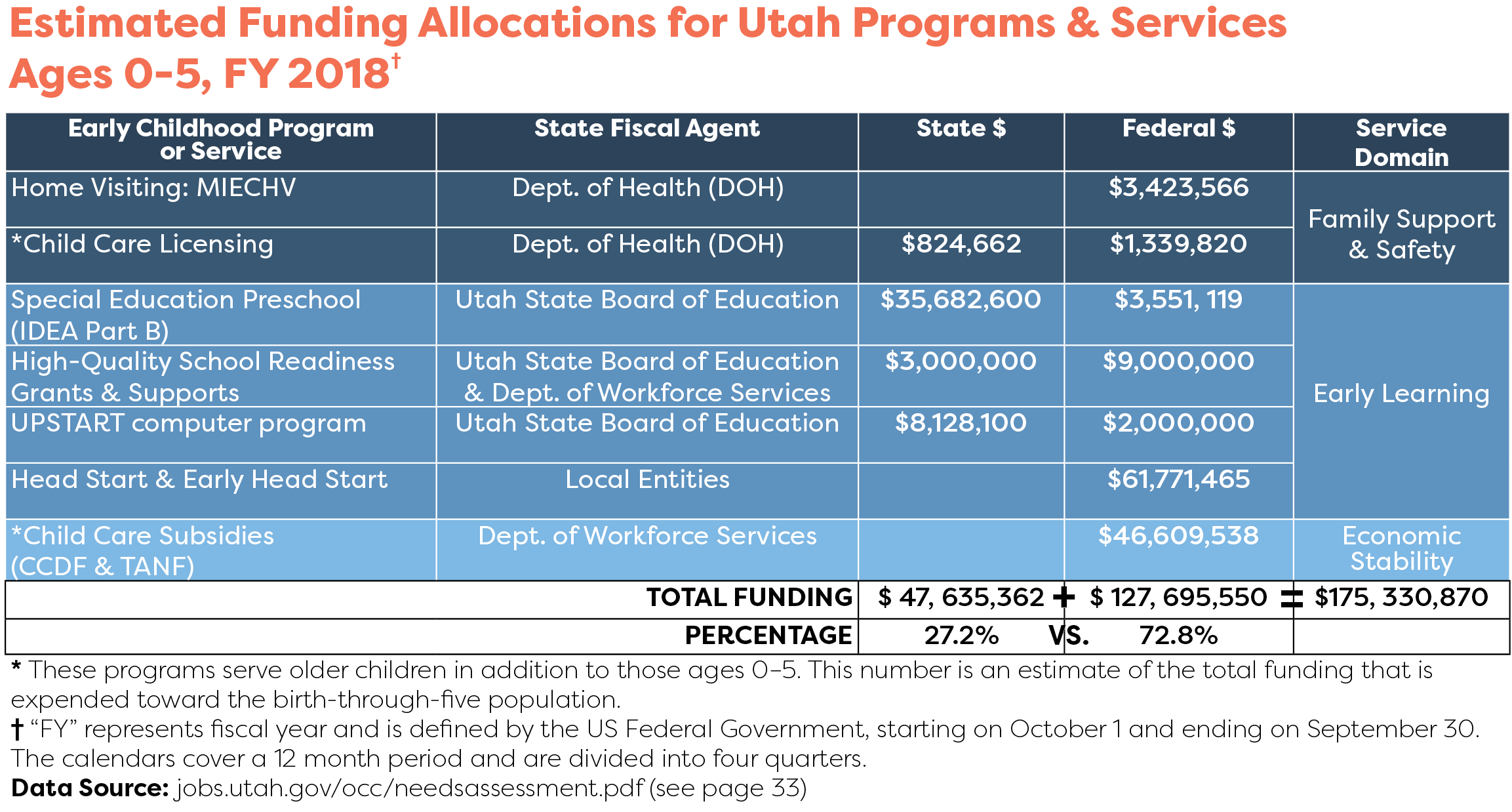
Why would having a full-time commission director make a difference?
When Utah’s Early Childhood Commission was proposed via legislation by Rep. Lowry Snow and Sen. Ann Millner during the 2019 General Session, the original concept contained funding for a full-time staff member to support the functioning and forward momentum of the new Commission. When the bill finally passed, this funding was removed. Since then, staffing for the Commission has bounced between the Lieutenant Governor’s Office and the Office of Child Care (in the Department of Workforce Services), with those responsibilities always falling to a hardworking public servant already tasked with multiple other critical education and child care projects.
One persistent issue with the coordination and alignment of Utah’s early care and education system is that there is no single entity, agency or individual committed to that effort.
Leadership, intention and single-minded commitment is needed to shepherd Utah’s early care and education system to the next level of improvement; currently, all stakeholders at the Early Childhood Commission table must juggle their early childhood work with multiple other state government responsibilities. (Thanks. Now take me back to where I was!)
What is a "weighted pupil unit" and why is it important?
A “weighted pupil unit” or WPU is the designated funding allocation provided by the state legislature to support the education of a single Utah public school student. Each year, the state legislature and the executive branch (including the Governor’s Office and the Utah State Board of Education) come to an agreement as to how many state dollars will be provided to each school, through its local education authority (or LEA, which can be a school district or a charter school) for each student enrolled for the next school year.
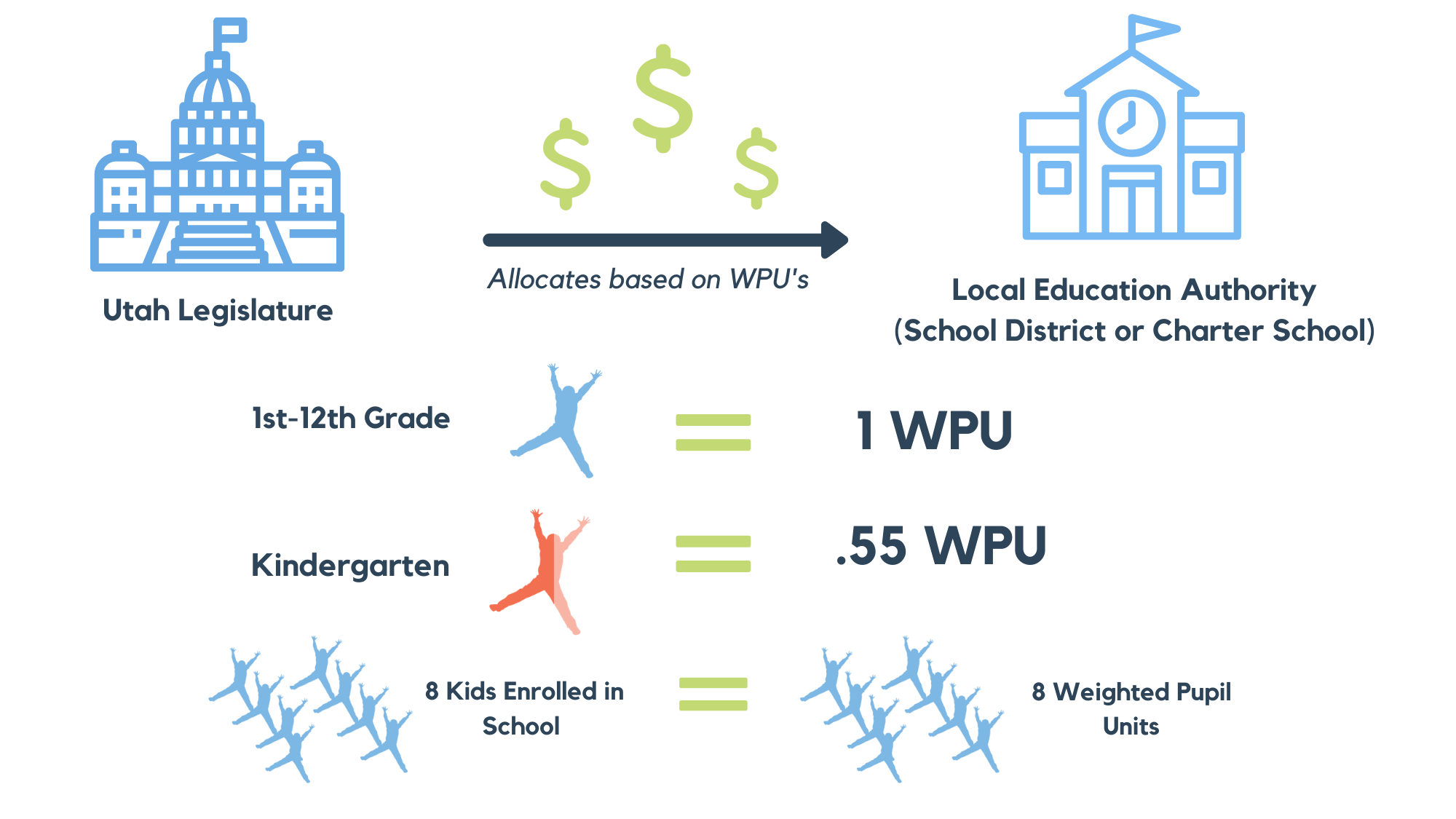
Currently, Utah ranks dead last in the nation - behind all others states and the District of Columbia - with regard to “per pupil funding.” This ranking has remained unchanged for years.
The state gives each school district only 55% of a weighted pupil unit for each enrolled kindergartner. All state-funded LEAs are required by law to provide at least one half day (two or more hours) of kindergarten education for interested families. (Okay, take me back to where I was!)
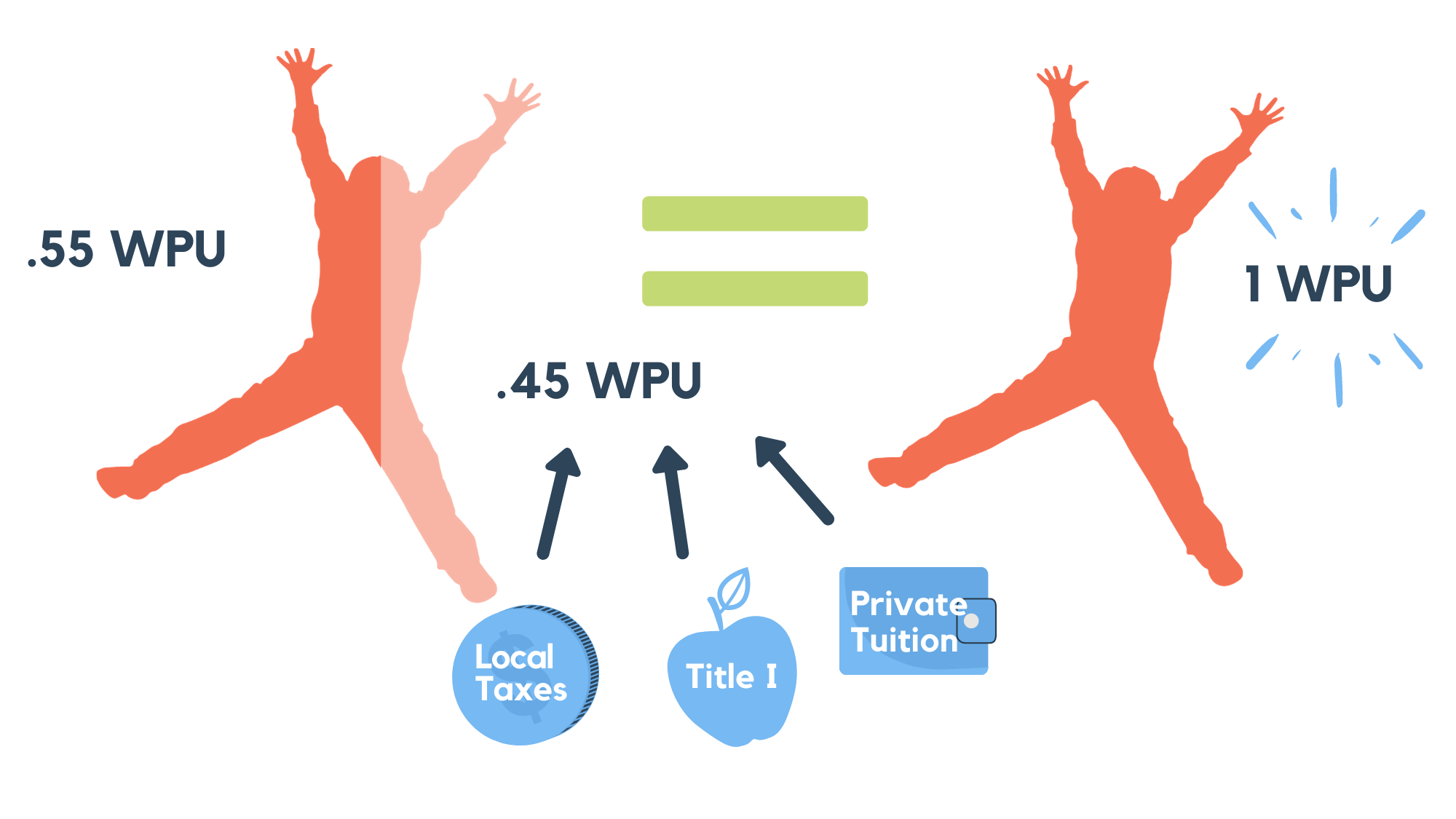
What is Utah's current level of participation in full-day kindergarten?
Across the United States, approximately 80% of kindergarteners attend a full-day kindergarten program. This figure has grown dramatically over the past twenty years (approximately 56% in 1999).
In Utah, however, as recently as 2019, only 20% of kindergarteners attended full-day kindergarten (with an additional 4% attending an “extended” day of schooling, such as an additional 45 minutes or more of academic intervention on top of the traditional half day of kindergarten education). (Thanks. Now take me back to where I was!)
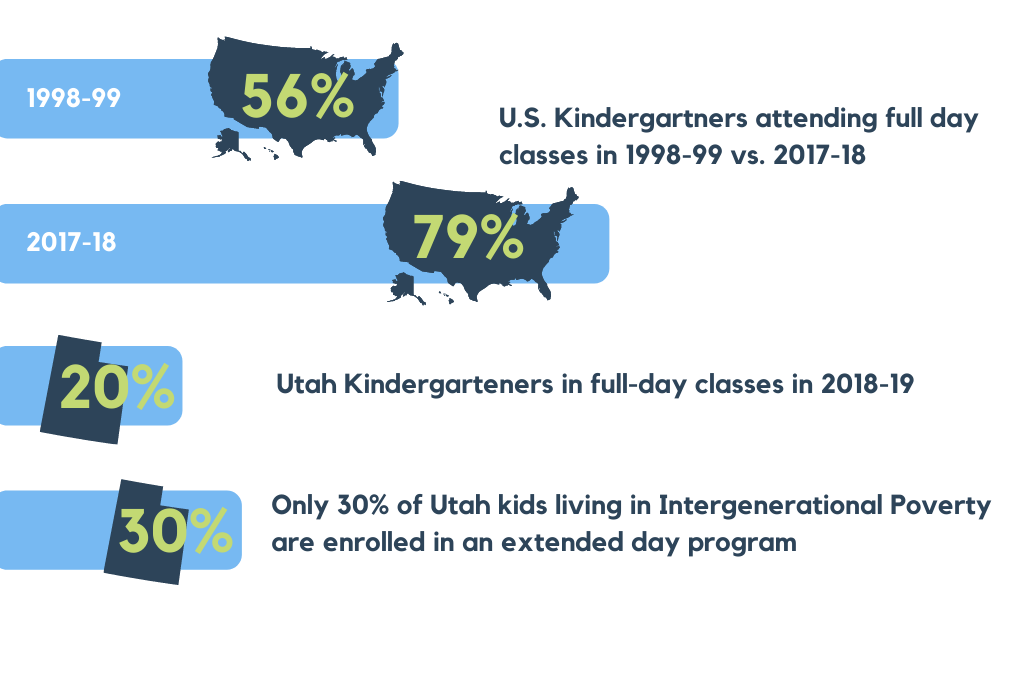
Indications that Utah is ready for more full-day kindergarten access.
In our report, “Three Things Utah Can Do to Ensure Right-Sized Access to Full-Day Kindergarten,” released in February 2020, we noted the following:
- In response to both parent interest and educator confidence in full-day learning interventions, multiple districts and individual schools have tapped federal and local funding (in lieu of sufficient state support) to open more classrooms for a full-day of kindergarten instruction;
- In every school district that has expanded access to full-day kindergarten (including Carbon SD, Rich SD, Ogden SD, Murray SD, Washington County SD, Grand SD, Granite SD, Salt Lake SD and Canyons SD), participation has been robust; and
- Families living in districts offering little or no access to full-day kindergarten in their neighborhood school, admit to registering their kindergarten-aged children in a different district, in order to enroll their child in a full-day program. (Okay, take me back to where I was!)
What is a "mixed-delivery system" for preschool?
A “mixed-delivery system” for preschool programming is one where a variety of different preschool providers are part of delivering preschool opportunities to families. A “mixed-delivery system” includes preschool classrooms in: public elementary schools; private child care centers; and community-based non-profit programs (such as the YMCA). In some mixed-delivery systems in other cities, counties and states in the U.S., government funding is used to provide access to preschool for families, who are allowed to select which type of preschool program (school-based, community-based or private provider) is the best fit for their child. (Thanks. Now take me back to where I was!)
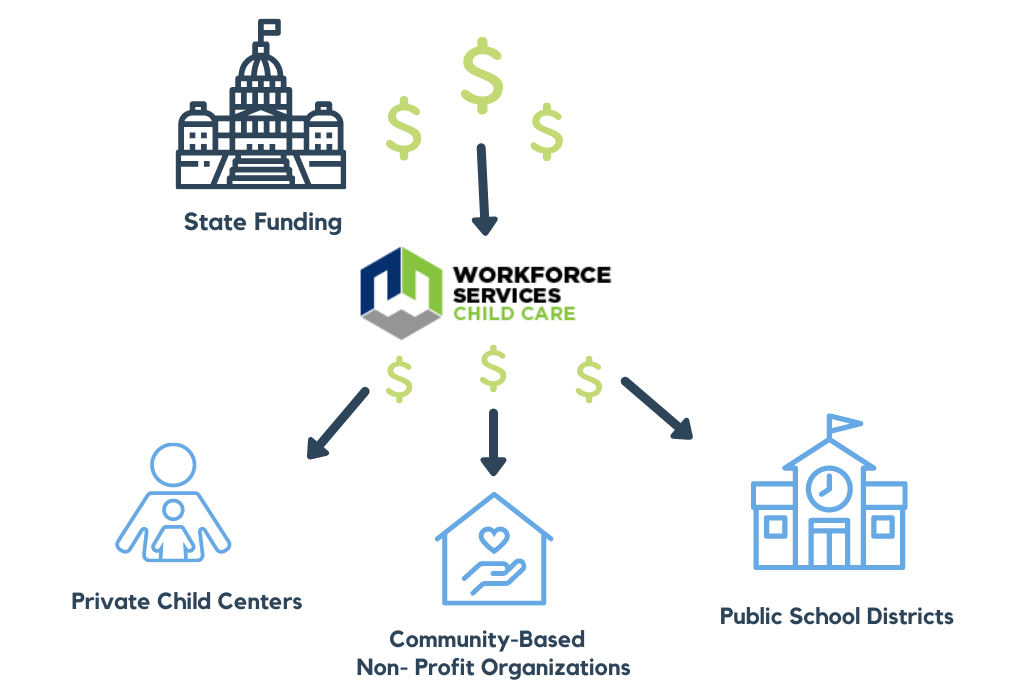
What is the state's current investment in preschool?
The only state funding explicitly available for preschool programs is the amount allocated annually, since 2014, for the High Quality School Readiness (HQSR). The program started with an allocated $7.5 million of baseline funding; there has been no increase since. This program was a state-funded continuation of a Pay-For-Success initiative pioneered by the United Way of Salt Lake in 2013. Under the HQSR program, school districts and private child care providers can apply for a performance-based grant to fund preschool “seats” in their classrooms. Since 2014, approximately 5,000 Utah preschoolers have participated in the program.
The National Institute for Early Education Research (NIEER) produces an annual report on which states in the U.S. have state-funded preschool programs. With the exception of the 2019-2020 report, each year, Utah’s state-funded preschool program has failed to meet the minimum criteria to be included in NIEER’s annual report. (Okay, take me back to where I was!)
How do childcare subsidies work, and why are these changes important?
Thanks to the federal government's Child Care and Development Fund, Utah is able to help low-income parents cover the cost of childcare while they are working, looking for work or training for work. During the current budget year (from July 1, 2020 to June 30, 2021), Utah will receive approximately $139 million in CCDF money, including an additional $40 million in one-time CARES Act funding to help with pandemic-related child care support. The federal government requires that at least 70% of this amount must be used to help families directly, through child care subsidies.
This additional funding, with more COVID relief dollars on the way, has allowed Utah to make several positive changes in its childcare subsidy program. These changes have made it possible for more families to get help paying for childcare services. The changes have also helped stabilize and support childcare providers, whose businesses have been hit really hard by the pandemic.
In normal times, a family must make less than 56% of the state median income (SMI) to qualify for a childcare subsidy. That is $44,016 for a family of four people (or 168% of the federal poverty level). Thanks to COVID relief funding, families that make up to 85% of SMI to qualify for help. That is $65,498 for a family of four people. Child care subsidies are paid directly to a childcare provider when a child enrolls. In normal times, Utah only pays for each day that the child attends childcare. This means subsidies can be an unstable and unreliable source of income for providers. Thanks to COVID relief funding, Utah now pays childcare providers based on enrollment - so providers don't suffer financially when families have to quarantine, stay home from work or become ill. We think these changes, and others made possible by increased investment in the last year, should be permanent. This will help more families in Utah access safe, affordable and quality childcare. (Thanks. Now take me back to where I was!)
What makes Utah's early childhood care and education system so "sprawling" and difficult to coordinate?
Currently, several different federal, state and local entities (including private businesses and non-profit organizations) are responsible for providing early care and education programs for Utah families with young children.
Office of Child Care (OCC)
The Office of Child Care (OCC), in the Department of Workforce Services (DWS), provides child care subsidies to help thousands of low-income Utah families afford child care. In addition to state licensing requirements, OCC has a new “Child Care Quality System” that gives participating child care providers a designated quality level, based on a number of different factors. The Office of Childcare also manages the High-Quality School Readiness (HQSR) program funded by the legislature, through which a limited number of three- and four-year olds are able to participate in structured preschool programs.
Office of Child Care Licensing (CCL)
The Office of Child Care Licensing (CCL), in the Utah Department of Health (UDOH), is in charge of making sure child care providers maintain a basic level of health and safety in their child care businesses.
Utah State Board of Education
In addition, the Utah State Board of Education has guidelines for preschool programs that are provided through the public school system. Those guidelines are separate from the guidelines schools and child care providers must follow if they are participating in the state’s High Quality School Readiness (Preschool) performance-based grant program.
Private Preschool Providers & Home-Based Preschool Programs
There are also many private preschool providers throughout the state who are not required to be licensed by the Office of Child Care Licensing and who are not governed by the Utah State Board of Education. These are the kind of home-based preschool programs that provide only a couple of hours of instruction per day, for families who are willing and able to pay privately.
Head Start and Early Head Start Programs
There are also dozens of Head Start and Early Head Start program sites throughout the state, which adhere to a completely different set of standards, set by the federal government, and which are largely independent of any state agency.
(Whew, that's enough! Take me back to finish the letter, please.)
Amendment G Passed. Now What Happens?
With Amendment G winning 54% of the vote this month, many of our partners and supporters have been asking us: What’s going to happen next?
What changes will result from this Constitutional amendment going into effect January 1, 2021, along with the legislation triggered by it (HB 357)?
The short answer is, “Probably not a lot, at least not immediately, but possibly quite a bit over the long term.”
As a result of the passage of Amendment G, the Utah Constitution Article XIII, Section 5, paragraph 5 changes from
“All revenue from taxes on intangible property or from a tax on income shall be used to support the systems of public education and higher education as defined in Article X, Section 2.”
to the following:
“All revenue from taxes on intangible property or from a tax on income shall be used:
(a) to support the systems of public education and higher education as defined in Article X, Section 2; and
(b) to support children and to support individuals with a disability.”
The state’s budget leaders sought this change because they expect the long-term trend to continue of Utah’s higher education budget shifting from the General Fund (which is financed mainly by the sales tax) to the Education Fund (which is financed mainly by the income tax). This shift has made it possible to make more of the General Fund available for social and healthcare services. But once higher ed has shifted completely out of the General Fund, something expected to happen in the coming years, then budget writers will no longer have a mechanism to free up additional funds to meet the state’s obligations for healthcare and social services. This concern is what drove the decision to place on the ballot a Constitutional amendment to allow budget writers to begin to shift additional items (services for children and for Utahns with disabilities) out of the General Fund and have them financed by the income tax.
In the FY21 budget passed by the Legislature in March and then adjusted in June (the FY21 budget year runs from July 1, 2020 through June 30, 2021), just 4% of the higher education budget came from the General Fund and the remaining 96% from the Education Fund. The chart below shows how the higher education budget has been divided between the two funds in recent fiscal years:
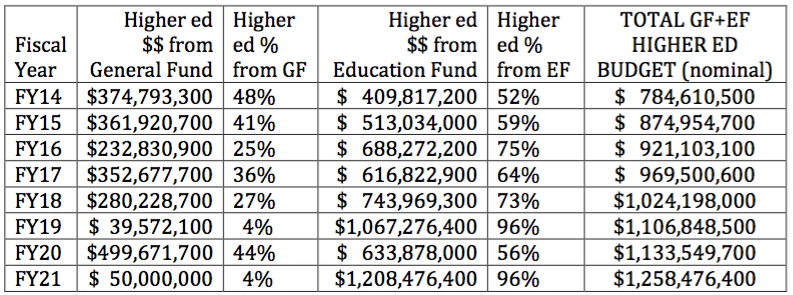
Source: Office of Legislative Fiscal Analyst annual publication “Budget of the State of Utah” at https://le.utah.gov/asp/lfa/lfareports.asp?src=LFAAR
While the trend has not been a straight line, the general direction has been to shift the higher education budget out of the General Fund and into the Education Fund. And, indeed, two of the last three budgets have seen 96% of the higher education budget come out of the Education Fund.
This trend has also been facilitated by the fact that income tax revenue has been growing faster than sales tax revenue.
Assuming these trends continue, we can expect to see the FY22 and future year budgets begin to make gradually increasing use of income tax revenue to finance social and healthcare services for children and Utahns with disabilities, two items that until now were only funded from sales tax revenue (through the General Fund).
What will be the impact of Amendment G on education funding?
As part of the political deal that produced Amendment G, the Legislature passed HB 357, with implementation contingent on voter approval of Amendment G. HB 357 contains three main provisions intended to provide education advocates with compensation for losing the Constitutional earmark of the income tax for education:
- It requires that “when preparing the Public Education Base Budget, the Office of the Legislative Fiscal Analyst shall include appropriations to the Minimum School Program from the Uniform School Fund… in an amount that is greater than or equal to:
(a) the ongoing appropriations to the Minimum School Program in the current fiscal year; and
(b) … enrollment growth and inflation estimates…”
This is intended to avoid what happened in the Great Recession a decade ago, when annual appropriations were not sufficient to keep up with inflation and enrollment growth, and it took almost a decade to restore real per-student education appropriations.
- It requires that 15% of education revenue growth go into a new “Public Education Economic Stabilization Restricted Account” to be saved for recessions until it reaches 11% of the full Uniform School Fund. This is intended to build up a new reserve fund of about $400 million to finance the first commitment mentioned above, the commitment that education funding will always increase by enough to cover enrollment growth and inflation, even in times of recession. This new annual 15% savings requirement will mean smaller education funding increases in good times and larger ones in bad times, in effect smoothing out the annual changes in education funding. It does not change the overall amount available for education budgets over the full course of each economic cycle.
- HB 357 allows local districts to reallocate capital funds to cover operating expenses in recession years. This is something that was allowed on a one-time basis in the Great Recession a decade ago. Now it will be allowed in any year when the Legislature makes use of the new Public Education Economic Stabilization Restricted Account.
What impact will Amendment G and HB 357 have on funding for social and healthcare services for children?
On the positive side, budget writers will now have increased flexibility to use income tax revenues that are now going to education for social and healthcare services for children and Utahns with disabilities. On the negative side, there are no new revenue streams and no rolling back of past tax breaks, and HB 357 does promise an increased commitment to education in recession years (presumably including the current one), so that seems to imply that there will be less available for everything other than education, at least in the short term.
What impact will this have in the coming year?
This depends on how much revenue there is. Will there be enough new education revenue to cover inflation and enrollment growth? And if not, how will the state budget cover that commitment supposedly contained in HB 357 since the new Public Education Economic Stabilization Restricted Account does not yet have any money in it? The Legislature may face the same difficult choices as in the last recession a decade ago between funding enrollment growth and inflation in the education budget or funding life-saving social and healthcare services. And if they choose to keep their promise to fund enrollment growth and inflation in the education budget in the absence of sufficient education revenues, then that commitment will come at the expense of other areas of the state budget, such as social and healthcare services for children.
One wild card here is the question of how the calculations will be impacted by the unprecedented drop in student enrollment that was reported this fall. Student enrollment had been projected to grow by 7,000; instead it fell by over 2,000. This drop is probably a temporary blip due to the impacts of the COVID-19 pandemic. But the Legislature may see it as an opportunity to go with a low-ball estimate of enrollment for FY22 when it meets to pass that year’s budget this coming winter. Doing so would certainly make it easier to keep its commitment to fund enrollment growth and inflation even in the current downturn.
What impact will this new arrangement have in the longer term?
On the negative side, the fact that Amendment G and HB 357 provide for no new revenue streams to roll back any of what now amounts to $2.4 billion every year in tax breaks enacted since 1995 (18% of public revenues) does not bode well for education, for social and healthcare services for Utahns in need, or for any of the many areas of state responsibility that suffer from chronic revenue shortages because of these revenue losses.
On the positive side, the promise made by the state’s leaders to always at least fund inflation and enrollment growth could potentially lead to an increased commitment of existing state resources to education than might have otherwise taken place. If that happens, and since the need for resources in other areas is not going to change, there is the possibility that members of the state’s budget leadership might move closer to public opinion, which has expressed consistent -- and growing -- willingness to pay more to achieve improvements in areas of state responsibility like education, transportation, and air quality, as evidenced by the results of the following public opinion surveys this year:
If that happens, then we will be able to say that Amendment G led to positive changes in state fiscal policy for the benefit of all of Utah’s children. But if not, then we may well be in for many years of budget writers using their newfound flexibility to grant substantial increases to one area of the budget one year and another the next, making different areas of the budget compete with each other to be that year’s “favored child,” but leaving none better off in the long run.
THIS PAPER IS ALSO DOWNLOADABLE AS A PDF HERE.
WE ALSO PRESENTED THIS PAPER AS A SLIDESHOW ON A FACEBOOK LIVE EVENT: https://www.facebook.com/watch/live/?v=380455343223086&ref=watch_permalink
For years, advocates (like me) have avoided mentioning the fact – at least, in the presence of legislators – that Utah families rely on school not just for education, but also for reliable and high quality child care.
Similarly, until very recently, many Utah policymakers were ignorant of the fact that child care – especially for infants, toddlers and pre-school aged children – is possibly the most critical education Utah families will ever invest in.
COVID-19 has made all this denial of reality much more difficult.
Right now, education administrators throughout the state are wondering how they could manage to implement a “staggered schedule” in their schools, when doing so would mean that teachers with school-aged children would require paid child care for half the workweek.
Parents working from home are realizing how much personal attention and educational interaction their children are able to receive in child care settings while they are working. Perhaps initially thrilled to save money on child care expenses, they are gaining renewed (perhaps desperate) appreciation for the intense, valuable work performed by their child care providers.
Families throughout the state are struggling with a diminished roster of summer camps, summer programs and summers schools. They are wondering how they are going to manage the cost of additional hours of child care that may be necessary in the fall, depending on how individual school districts choose to “re-open” their schools.
Utah families and educators are all re-learning, under great pandemic-driven duress, something that has been the truth for decades: school is child care, and child care is school.
In Utah, about 47% of all kids under age six, who are living with both parents, have both of those parents in the workforce.* Among kids between 6 and 17, who are living with both parents, that number jumps to 57%.* That increase represents a lot of Utah parents, going back to work, as soon as their young kids are able to attend kindergarten.
More than 54,000 children under the age of six live with only one parent.* For 83% of those young children, the single parent they live with is in the workforce.* Among kids between 6 and 17, who are living with only one parent, that number jumps to 98%.* Again, that increase represents a lot of Utah parents, going back to work, as soon as their young kids are able to head off to public school.
The vast majority of Utah parents appreciate that for six or seven hours a day, five days a week, for around 36 weeks out of the year, they are able to put their children in the care of trained professionals, in a relatively safe environment, at little or no cost to their family.
Their children are being educated in all manner of subjects, and they are learning to socialize with other children from different families and backgrounds. They also are under the watchful eye of educators acting “in loco parentis,” a common law principle that empowers educators to take on some of the functions and responsibilities of a parent during school hours and activities.
This all-encompassing educational and social experience is provided to Utah families largely for free – by law – because primary education is regarded generally as a public good. Ensuring that all people receive a basic level of education, regardless of their ability to pay for it otherwise, is good for all of us. Public education advances important goals like equal opportunity, work force preparation and an educated populace.
Most Utah parents feel comfortable reading, writing, doing basic math, socializing with other people, finding (some) foreign countries on a map, and playing sports. But, as the pandemic lockdown has reminded so many, not all Utah parents feel qualified to be primarily responsible for teaching their children how to do all those things. No wonder fewer than 5% of school-aged children in Utah are homeschooled.**
It just so happens that public education also provides hundreds of hours of free, high-quality child care to Utah families while accomplishing those important societal goals. School is many things, and yes, it is also child care.
The more we learn about the incredible amount of brain development that occurs in early childhood, the stranger it seems that we, as a society, are still unwilling to acknowledge the reverse: child care is many things, and yes, it is also school.
Many Utah policymakers and elected officials still insist that “child care is a family issue” that should be left up to families to figure out. Families with young children are expected to either care for their children all day, or find someone else to do it for them. Under this model, all the inconvenience, confusion and cost associated with child care fall on individual families.
But our demographics show that this approach is painfully outdated.
Nearly 54% of all Utah children under age six live in a household with all available parents working. The parents of those children are not in a position to fulfill all the responsibilities of teaching, socializing, reading and playing with their children. Those families need the support of child care professionals who, in addition to providing a safe and caring environment for children while their parents are working, are also teaching, socializing, reading and playing with those children.
Unlike public school, however, there is an enormous cost associated with this invaluable service. Subsidies are only available to those Utah families making the least amount of money, while almost all Utah families (of any income level) struggle to afford the cost of child care for infants, toddlers, and preschool-aged children.
Most families can’t homeschool their school-aged children, because they work outside the home (or inside the home for many due to COVID19). Most families also can’t pay for private school, because they don’t make enough money from their work outside the home. Luckily, public school is available for all those families.
Most families can’t stay home to care for and teach their infant, toddler and pre-school aged children, because they work outside the home. Yet, we still expect them to pay for child care, even when they don’t make enough money from their work outside the home to afford the early care and education their children deserve.
We need to stop tip-toeing around the fact that Utah families rely on school not just for education, but for safe and highly-effective child care. We need to embrace it. At the same time, we need to embrace the reverse truth: that safe, high-quality childcare is also the equivalent of “school” for young children.
Safe, effective, high-quality care and education for Utah children of all ages is a public good. Treating child care and public education as part of the same important system of learning and development will create enormous benefit for these children, and, by extension, the rest of the state.
* Figures from the 2018 American Community Survey, accessed at data.census.gov.
** Calculated from data made available by the Utah State Board of Education on homeschooled children and public school enrollment in the 2015-16 school year (the most recent data reported on the USBE website at https://www.schools.utah.gov/data/reports?mid=1424&tid=4).
Special thanks to Erin Jemison, formerly of YWCA Utah and now with Community Resources for Justice's Crime & Justice Institute, for contributions to this post.

